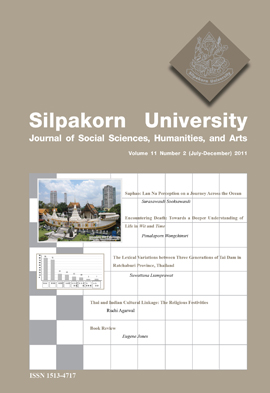Encountering Death: Towards a Deeper Understanding of Life in Wit and Time
Main Article Content
Abstract
Even though people know everyone has to die one day, it seems nobody realizes that this is a truth of life and they themselves are going to die. This is apparently a universal problem for all people and it causes them to live their lives in forgetfulness until the day they have to encounter death. This article aims to explore how the narrative techniques employed in Margaret Edson’s Wit and Chart Korbjitti’s Time induce each individual reader to contemplate death and meaning of life and stimulate them to question, criticize and evaluate his/her own life.
Downloads
Article Details
All rights reserved. Apart from citations for the purposes of research, private study, or criticism and review,no part of this publication may be reproduced, stored or transmitted in any other form without prior written permission by the publisher.
References
Edson, M. (1999) Wit. NY: Faber and Faber.
Halliday, J. (1988) The Theory and Analysis of Drama. Tran. And Ed. Manfred Pfister Cambridge: Cambridge University Press.
Hornstein, H. L. (2002) The Reader’s Companion to World Literature.New York: Penguin Books.Kemerling, G. Socrates: Philosophical Life. [Online URL:http://www.philosophypages.com/hy/2d.htm] accessed on July 15, 2010.
Kobjitti, C. (2003) Time. Trans. Marcel Barang, Nakhon Ratchasima: Howling Books.
Nagavagara, C. (1996) Comparative Literature from a Thai Perspective:Collected Articles 1978-1992. Bangkok: Chulalongkorn University Press.
Pradittatsanee, D. (2003) “Love and Knowledge in Margaret Edson’s Wit.” (in Thai) Journal of the Faculty of Arts Chulalongkorn University, January-June: 87-109.
Somdet Pra Nyansamvara, the Supreme Patriarch of Thailand,‘Death.’ (2010) Contemplating Death: A Buddhist Way to Welcome Death. (in Thai) (Panwadee Wasinwattana et.al, eds), pp. 5-16 Bangkok: Komon Keemthong Foundation.


